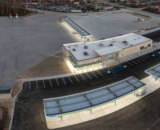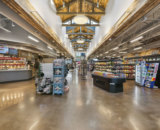Truckstop and travel plaza operators know signage matters. Whether it is a large billboard or a small pump topper, getting the message across can get customers to stop and secure an additional sale. While operators know signs can carry a powerful punch, they also know that they need to differentiate themselves from the competition. NATSO members nationwide are turning to LED lighting, digital signage and strategic placement to promote their offerings.
LED Love
Over the past five years, the use of electronic price signs and reader boards has increased. “Price, clean restrooms, an attractive food offering, and the feeling of safety that comes from a well-lit location continue to move the needle in the attraction of four-wheel and women customers,” said Robin Hood, LSI Industries, Inc. “The utilization of LED digital signage, whether with alternating static images or full-motion video, is a great tool to deliver these messages.”
Operators told Stop Watch they’ve seen the benefits of electronic signs. When Bob Wollenman, Deluxe Truck Stop, remodeled recently, he installed fuel and logo signage from Sunshine Signs. “The nice thing about it is the illumination is LED. It has an energy savings and the illumination is brighter,” he said.
Sunshine Signs manufactures large, LED pricing signs. “A lot of them are going to have the option of being able to flash cash and credit pricing for diesel. We’re starting to see some demand for DEF pricing and for CNG and LNG pricing,” said Kendall Randolph, Sunshine Signs.
While electronic signs look nice, operators often appreciate their addition- al features. Wollenman said one of the biggest benefits of his electronic signs is the ease of operation. “One of the biggest challenges in the operation of truckstops and c-stores is changing the pricing. When I was first in the c-store business you were out changing signs every day. When it was cold numbers would be frozen to the sign. I know a lot of people take it for granted today, but we just take a handheld keypad and say this is what is going to be and hit send,” he explained.
The pricing changes on Sunshine Signs’ signs are done wirelessly through cellular modems. “There is a lot of two-way communication. Things are getting smarter,” Randolph said. “Having that accurate fuel price has become very important. There is more volatility in the pricing, so having the ability to update and verify the updates is becoming more important.”
LED lighting and signage not only makes a greater impression, but it also dramatically reduces energy consumption by 75 percent or more. “With the large footprint truckstops and travel plazas utilize, this opportunity for reduction in operating cost is getting a lot of attention,” Hood said.
Jim Coppins, vice president of operations for I.C.E. Signs, said, “LED is efficient, has a low burn-out rate and is environmentally friendly. People are moving to LED for signage outdoors, in the store, parking lot—it is almost end- less because of the cost efficiencies."
Coppins said he is also seeing more LED signs with scrolling messages, which can promote everything from fuel prices to sandwiches. “It gives you the multi-faceted marketing ability to pro- mote the fuel price but also the other features that will hopefully get them to exit,” he said. “You can put out multiple messages over and over again with great ease and put many different messages up.”
Jim Miller, Port to Plains Truckstop, uses signs from I.C.E. Sign and has in- stalled a digital sign on the secondary highway where his location sits. “We rotate the sign three times a day. We have a huge restaurant, so we have specials morning, noon and night, and we have daily specials in our shop and our garage,” he explained, adding that programming the sign is easy.
“We don’t have any pure data to back it up, but I believe it is really effective for a business,” Miller said. He acknowledged that the signs are costly, saying he spent nearly $30,000. “Sometimes you get what you pay for. We have high winds and these hold up very well. We haven’t had issues since we installed them.”
However, when it comes to LED signage in general and those with scrolling messages, local regulations may dictate what operators can use.
“The local legislation or regulations vary greatly from city to city and state to state,” Randolph said. “Quite a few of our customers use billboards to post prices, but there are some regulations on what you can put on bill- boards. An example is that the signs cannot flash,” Randolph said.
Coppins said scrolling signs can be restricted in certain areas and along the interstate. “We’re in New Hampshire and the town south of us can have them, but the one to the north of us can’t,” Coppins said, adding that the I.C.E. Signs can help customers deter- mine their local restrictions.
Randolph told Stop Watch some areas also regulate the usage of LEDs and their light output. “If they exceed that light output, they’re not legal. There are some areas that are almost prohibiting LEDs,” he explained, adding that rural areas typically allow the use. Sign manufacturers told Stop Watch they can help operators navigate their local and state regulations on signage.
Greg Stadjuhar, Skyline Electronic Price Displays, said that while the company offers both LED and scroll pricing signs, sales of the scroll signs, which use numerals that scroll left to right when they need to be updated, are on the rise. “We’ve seen a growing trend to come back to what we see as the scrolling technology. It is green and uses less energy than a LED. It gives a bold and constructive look,” Stadjuhar said. “It comes down to, ‘Do you want your name to shine or your price to shine?’ We offer both.”
Stadjuhar said Skyline Electronic Price Displays’ studies have found that drivers traveling down the highway will see a LED sign first but the scroll sign is legible first. “You can see a LED sign from 2,000 feet, but you’re able to read it from 1,100 feet away. You can read a scroll from 1,300 to 1,400 feet away,” he explained.
Inside Inspiration
Operators want to attract drivers traveling down the interstate, but they also want to boost sales within the store. To do that, they are working to balance getting the message across without cluttering the store.
“The thing about advertising in- store is you don’t want to get too busy. People are so inundated with visuals that it has to be something that is set apart and folks want to look at and it needs to be clean,” said Chauncey Taylor, Johnson’s Corner.
Taylor uses pump toppers and electronic reader boards within the c-store. Taylor works with a graphic designer and his marketing expert to design the on-site signs that change seasonally. “We’ll generate different concepts and ideas that will fit into the standard-size toppers and signage that the sits on the nozzle hose,” he said.
Taylor and his team also generate slide shows that run on electronic reader boards he purchased at Best Buy. The boards are within the c-store and the fountain/to-go area. “That will direct people to our deli area where they can get hot food—burritos, pizzas, etc.,” Taylor said. “They’re just above eye level and they’re very visible.”
The reader boards rotate four to six messages throughout the day. To deter- mine what to advertise on the reader board, Taylor works with his managers to select new items coming online and those items with good margins.
To help operators promote their food offerings, LSI Industries offers menu board systems that can be illuminated and sized to fit small spaces. They can also be static or digital. “Menu systems have become more important with the emphasis on fresh food—these now range from more at- tractive and informative static graphic options than before to digital systems that provide the ultimate in flexibility and impact,” Hood said.
I.C.E. Signs offers Glowrite signs that are similar to a dry-erase board but use a perma-opaque marker that will glow and the writing will show in seven different colors. “It can switch colors quickly or show a gradual effect,” Coppins explained.
Coppins said the signs can help draw attention to grab-and-go and restaurant offerings and cost around $150. The writing will stay in place until wiped down with cleaner. “There is nothing worse then when you write a dry-erase message and some joker comes along and ruins it. With this, you can’t wipe it off with your finger.”
The Glowrite signs are so popular, Coppins said he has hard time staying ahead of production. “The owners of the signs love them,” he said.
No Wasted Space
Customers at Tomahawk Auto Truck Plaza locations can’t miss the newest signs, which grace the floor. Scott Paulson, Watkins Co. dba Tomahawk Auto Truck Plaza, is promoting everything from grab-and-go food options to ice using floor decals. Paulson first saw the displays in grocery stores and thought he could apply it to the truckstop. Paulson said, “I started out with one that was an ice decal that said, ‘Got Ice?’”
Since then, Paulson has expanded the decals to promote milk and food specials. A local sign shop makes the decals, which cost around $10 each. “We get the vendors to kick back a little to offset it,” Paulson said.
“The managers have fun with it and the customers seem to notice them,” Paulson said. “It is hard to quantify the benefit, but the morale is enhanced be- cause people have fun.”
Paulson said the decals are durable, last 45-60, days and go up and down easily. “There is no scarring and no razor blade is needed,” he said. While decals stick well, but Paulson said they’ve learned not to put them in front of the walk-in cooler where the soda guys will be scraping.
Signage as Customer Service
While most signage is used to promote services or products, Taylor has teamed up with the Colorado Motor Carriers Association and the Colorado Department of Transportation to install three, 52-inch monitors that display images from real-time traffic cameras located on I-25 and I-75. “They show real photos and information by our restaurant, truckers lounge and kiosk,” Taylor said. “We’re trying to provide full information and enhanced travel safety to drivers.” More information on the partnership can be found here.
Expand Your Signage
Operators interested in adding new signage can purchase them from these NATSO allied members.
Headrick Signs & Graphics
Louis P. Smith
louis@headricks.com
800-227-4466
I.C.E. Signs
Michael Garceau
mgarceau@icesigns.com
603-347-3005
LSI Industries
Vicki Rea
vicki.rea@lsi-industries.com
513-793-3200 x 3057
Ping HD
Bob Sabo
bsabo@pinghd.com
630-416-9591
Skyline Electronic Price Displays
Mark Morris
markmorris@skylineproducts.com
719-659-9999
Sunshine Electronic Display Corp.
John Waller
johnw@sunshine.us.com
816-387-4248
|
This article originally ran in Stop Watch magazine. Stop Watch provides in-depth content to assist NATSO members in improving their travel plaza business operations and provides context on trends and news affecting the industry. The magazine is mailed to NATSO members bimonthly. If you are a member and not receiving Stop Watch, submit a request to be added to the mailing list. Not a member? Join today or submit a request to receive additional information. |
Subscribe to Updates
NATSO provides a breadth of information created to strengthen travel plazas’ ability to meet the needs of the travelling public in an age of disruption. This includes knowledge filled blog posts, articles and publications. If you would like to receive a digest of blog post and articles directly in your inbox, please provide your name, email and the frequency of the updates you want to receive the email digest.

